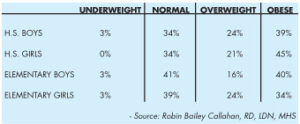COMMENTARY By ROBIN BAILEY CALLAHAN, RD, LDN, MHS
Childhood obesity is a major public health problem. The 2007-2008Centers of Disease Control (CDC) state 17% of US children are obese. Data for height and weight for age from 2011 Cherokee Central Schools are shown in the chart at right.
 There is no single or simple solution to childhood obesity. It is influenced by many different factors, including a lack of access to healthy food and drinks as well as limited opportunities for physical activity in the places where children live, play and learn. Working together, states, communities, and parents can help make the healthy choice the easy choice for children and adolescents.
There is no single or simple solution to childhood obesity. It is influenced by many different factors, including a lack of access to healthy food and drinks as well as limited opportunities for physical activity in the places where children live, play and learn. Working together, states, communities, and parents can help make the healthy choice the easy choice for children and adolescents.
Cherokee Central Schools (CCS) menu changes are being phased in as a result of the Healthy, Hunger-Free Kids Act (HHFKA), a federal law which marks the first changes to school nutrition in over 15 years. The changes will be implemented over a three-year period. According to the USDA, some of the changes to the National School Lunch Program (NSLP) include: daily serving of fruits and vegetables; a weekly requirement for dark green or red/orange vegetables, legumes, starchy and other vegetables; weekly meat plus a daily requirement; and a requirement that half of the offered grains during a week must be whole grains. Guidelines also include restrictions on calories, saturated fat, trans fat, and sodium.
Along with the school lunch changes, the school also has a ban on fast foods and there are no fryers, everything is baked, broiled, or steamed. CCS has implemented a “Stop Light Guide for Healthy Eating” so kids can learn about what foods are GO anytime foods that are good for their bodies, SLOW sometimes foods that can slow them down, and RED whoa foods they should STOP and think about before they eat.
Challenges with the new menu implementation include complaints from parents that the school is not feeding their kids enough. This is one of the main concerns the CCS & SHAC (School Health Advisory Committee) is working to address by getting feedback on menu items and promoting healthy snacks. It is natural to be hungry three to four hours after you eat. Therefore, having eating a healthy breakfast and having a healthy snack in the afternoon is key to giving kids the energy they need and keeping them from getting over hungry and overeating. Students in the Cherokee Elementary School receive a fruit or vegetable as a snack from the USDA Fresh Fruit and Vegetable Grant. It is encouraged for students in the Cherokee Middle School and Cherokee High School to pack a healthy snack (refer to healthy snack list for ideas). Parents also have the option of packing their child’s lunch, though all students are eligible for a free lunch under the program. Encouraging and ensuring that your kids eat breakfast either at home or school helps to create a healthy foundation for learning and keeps them from getting hungry throughout the day.
Meeting the USDA NSLP meal requirements provides the school with funding each year to provide free lunches for CCS students. Providing foods that follow the new healthier school lunch program helps to promote optimal health and prevent chronic disease such as type 2 diabetes, high blood pressure, heart disease, and some cancers. The entire community needs to work together to succeed in providing good nutrition for future generations.





